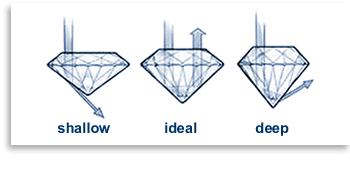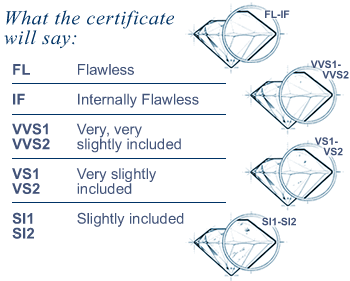We hope that your experience at Diamond Showcase will be both memorable and educational. Buying a diamond can be an intimidating process unless you are equipped with the tools you need to make an informed decision.
This Diamond Buyer's Guide was designed to give you those tools. We explain the importance of the "5 C's," and provide additional industry facts and information.
Cut
In order for a diamond's fire and brilliance to be maximized, it needs to be cut within specific parameters. An "ideal" cut round diamond as defined by the American Gem Society has a table of between 47 and 61 percent and a depth of between approximately 58 and 62.3 percent of the diamond's total width. The majority of round diamonds do not fall within these parameters and those that do are by far the most expensive.
At Diamond Showcase, we access a large selection of ideal cut diamonds as well as near-ideal diamonds. There are other desirable specifications for fancy cut (not round) diamonds. It is important that you buy a well cut diamond, as poorly cut stones allow light to leak through the bottom and sides, reducing their brilliance.

 Carat
Carat
A carat is a measure of weight used when describing a diamond, not a measure of size. Due to the various shapes and volumes provided by the diamond's cut, the apparent size of a diamond can vary within stones of the same carat weight. One carat is equal to 200mg or 0.2g.
Carat weight affects the value of a diamond exponentially. A two carat diamond is worth much more than twice as much as a one carat diamond, all other things being equal. Prices reflect rarity, and a two carat diamond is much rarer than a one carat, and therefore, it carries a price premium beyond its weight alone. One carat diamonds can appear larger or smaller due to cut dimensions.
Cost
Diamonds are generally priced based upon the Rapaport Diamond Report, the industry's standard pricing guide. Unfortunately, appraised values, retail price quotations, as well as Rapaport pricing, usually fail to take into consideration factors other than carat weight, color, cut and clarity.
In order to accurately assess the value of a diamond, one must consider the three traditional factors in combination with the diamond's grading reports and additional measurements, such as depth, table, girdle, culet, polish, and symmetry. Diamond Showcase sells diamonds between zero and twenty five percent below Rapaport wholesale, depending on these factors.
Well-cut diamonds with GIA or AGS certifications almost always trade at higher prices than non-certified or diamonds certified at other laboratories. In order to accurately evaluate one diamond against another, it is necessary for the consumer to understand the importance of all the factors that affect the ultimate value of a diamond and see the stones in person.
Color
A diamond is like a prism. White light enters and divides into a spectrum of color. This spectrum reflects in colorful flashes of light called fire. A diamond which contains color, from yellow to brown, acts like a filter on the entering white light, diminishing the spectrum of light which reflects out.
Less color is better. A diamond's color is determined by comparing it under controlled light to the GIA's (Gemological Institute of America) color scale. The most valuable and sought after stones are those with no observable color. These stones are given a D rating on the color scale. The scale ranges from D (highest) to Z (lowest), as shown below.
Clarity
Surface irregularities and the amount of internal inclusions determine a diamond's clarity. In order to determine clarity, a diamond is viewed under a magnification of 10x. The fewer internal inclusions and surface irregularities a diamond has, the higher the clarity rating it will receive. Clarity is also influenced by the size, color, type and location of inclusions.
A higher clarity indicates a more rare and valuable diamond. However, higher clarity does not necessarily mean a more beautiful diamond since many inclusions and surface irregularities are not visible to the human eye. At a clarity level of SI2, inclusions and surface irregularities cannot be seen by the average naked eye. Diamonds with a clarity rating higher than SI2 are sought after more for their rarity than for their greater beauty.


